Exploring Digit Ratios, Carrying Angles and Gender Differences
VerifiedAdded on 2022/11/29
|9
|1319
|248
Report
AI Summary
This report delves into the analysis of digit ratios (specifically the 2D:4D ratio) and carrying angles, exploring their variations across genders and their potential biological and endocrine bases. The study examines the methods used to measure these parameters, including the lengths of the second and fourth digits and the angles of the arms. It presents statistical data, including means, standard errors, and ranges, to highlight the differences in digit ratios and carrying angles between males and females. The report discusses the influence of prenatal testosterone exposure on digit ratios and how this relates to sexual dimorphism. Furthermore, it investigates the concept of carrying angles, their normal ranges, and how deviations can indicate physical conditions. The findings suggest that the 2D:4D ratio is negatively correlated between males and females, indicating gender-specific differences, and that carrying angles also vary. The report concludes with a discussion of the endocrine basis of these variations, emphasizing the role of hormones in shaping these anatomical features. The report is contributed by a student to be published on the website Desklib, a platform which provides all the necessary AI based study tools for students.

QUESTIONS
Paraphrase This Document
Need a fresh take? Get an instant paraphrase of this document with our AI Paraphraser
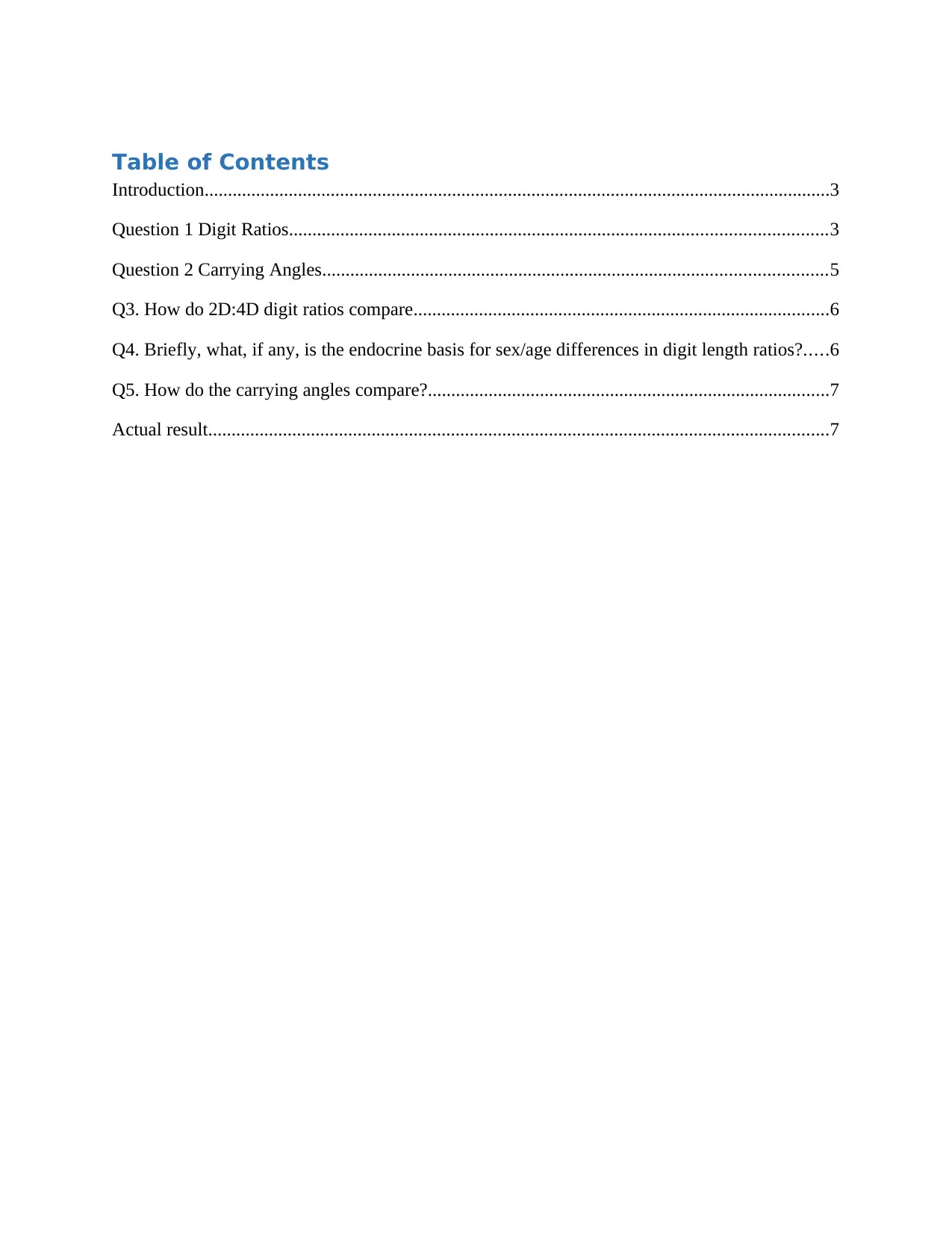
Table of Contents
Introduction......................................................................................................................................3
Question 1 Digit Ratios...................................................................................................................3
Question 2 Carrying Angles............................................................................................................5
Q3. How do 2D:4D digit ratios compare.........................................................................................6
Q4. Briefly, what, if any, is the endocrine basis for sex/age differences in digit length ratios?.....6
Q5. How do the carrying angles compare?......................................................................................7
Actual result.....................................................................................................................................7
Introduction......................................................................................................................................3
Question 1 Digit Ratios...................................................................................................................3
Question 2 Carrying Angles............................................................................................................5
Q3. How do 2D:4D digit ratios compare.........................................................................................6
Q4. Briefly, what, if any, is the endocrine basis for sex/age differences in digit length ratios?.....6
Q5. How do the carrying angles compare?......................................................................................7
Actual result.....................................................................................................................................7
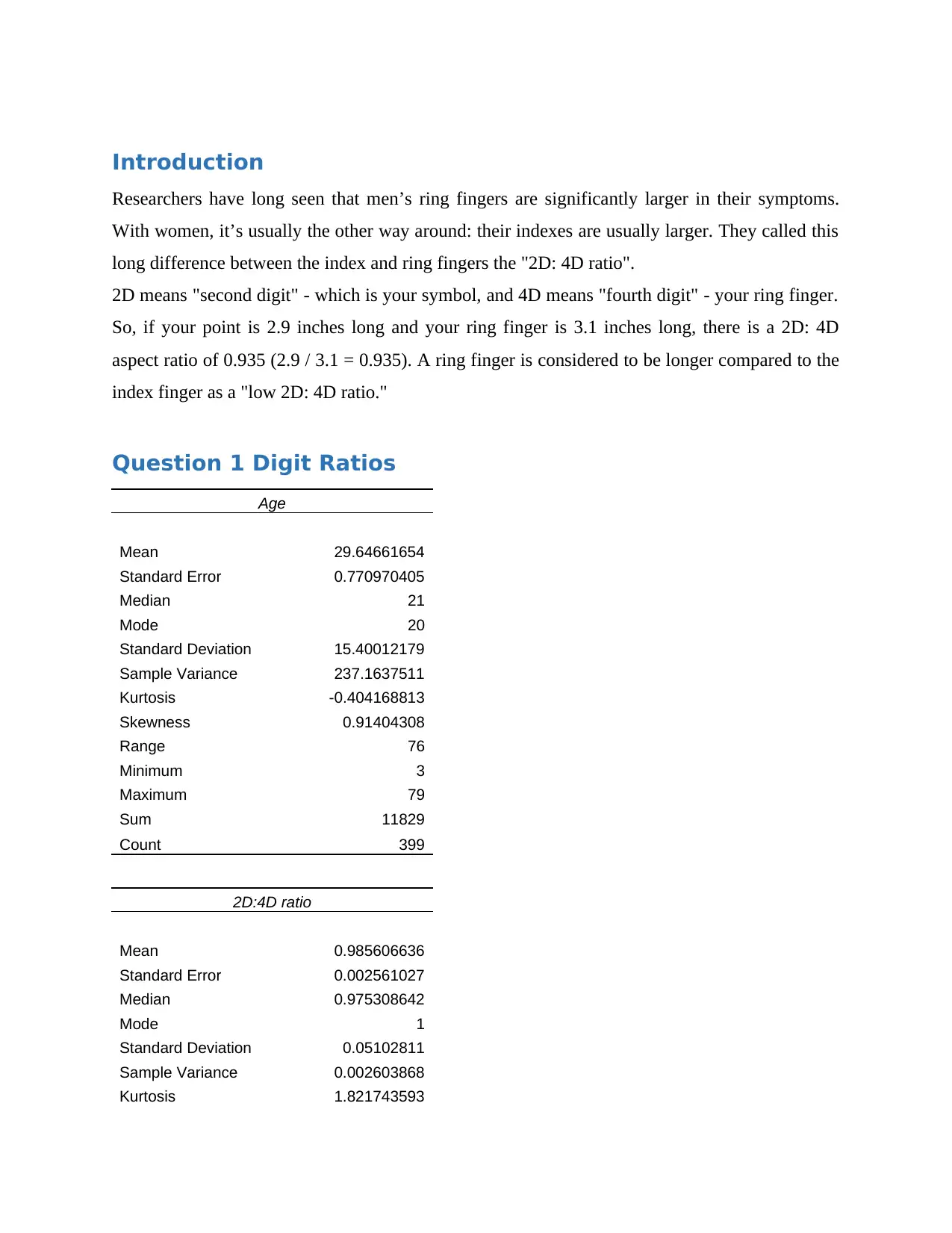
Introduction
Researchers have long seen that men’s ring fingers are significantly larger in their symptoms.
With women, it’s usually the other way around: their indexes are usually larger. They called this
long difference between the index and ring fingers the "2D: 4D ratio".
2D means "second digit" - which is your symbol, and 4D means "fourth digit" - your ring finger.
So, if your point is 2.9 inches long and your ring finger is 3.1 inches long, there is a 2D: 4D
aspect ratio of 0.935 (2.9 / 3.1 = 0.935). A ring finger is considered to be longer compared to the
index finger as a "low 2D: 4D ratio."
Question 1 Digit Ratios
Age
Mean 29.64661654
Standard Error 0.770970405
Median 21
Mode 20
Standard Deviation 15.40012179
Sample Variance 237.1637511
Kurtosis -0.404168813
Skewness 0.91404308
Range 76
Minimum 3
Maximum 79
Sum 11829
Count 399
2D:4D ratio
Mean 0.985606636
Standard Error 0.002561027
Median 0.975308642
Mode 1
Standard Deviation 0.05102811
Sample Variance 0.002603868
Kurtosis 1.821743593
Researchers have long seen that men’s ring fingers are significantly larger in their symptoms.
With women, it’s usually the other way around: their indexes are usually larger. They called this
long difference between the index and ring fingers the "2D: 4D ratio".
2D means "second digit" - which is your symbol, and 4D means "fourth digit" - your ring finger.
So, if your point is 2.9 inches long and your ring finger is 3.1 inches long, there is a 2D: 4D
aspect ratio of 0.935 (2.9 / 3.1 = 0.935). A ring finger is considered to be longer compared to the
index finger as a "low 2D: 4D ratio."
Question 1 Digit Ratios
Age
Mean 29.64661654
Standard Error 0.770970405
Median 21
Mode 20
Standard Deviation 15.40012179
Sample Variance 237.1637511
Kurtosis -0.404168813
Skewness 0.91404308
Range 76
Minimum 3
Maximum 79
Sum 11829
Count 399
2D:4D ratio
Mean 0.985606636
Standard Error 0.002561027
Median 0.975308642
Mode 1
Standard Deviation 0.05102811
Sample Variance 0.002603868
Kurtosis 1.821743593
⊘ This is a preview!⊘
Do you want full access?
Subscribe today to unlock all pages.

Trusted by 1+ million students worldwide
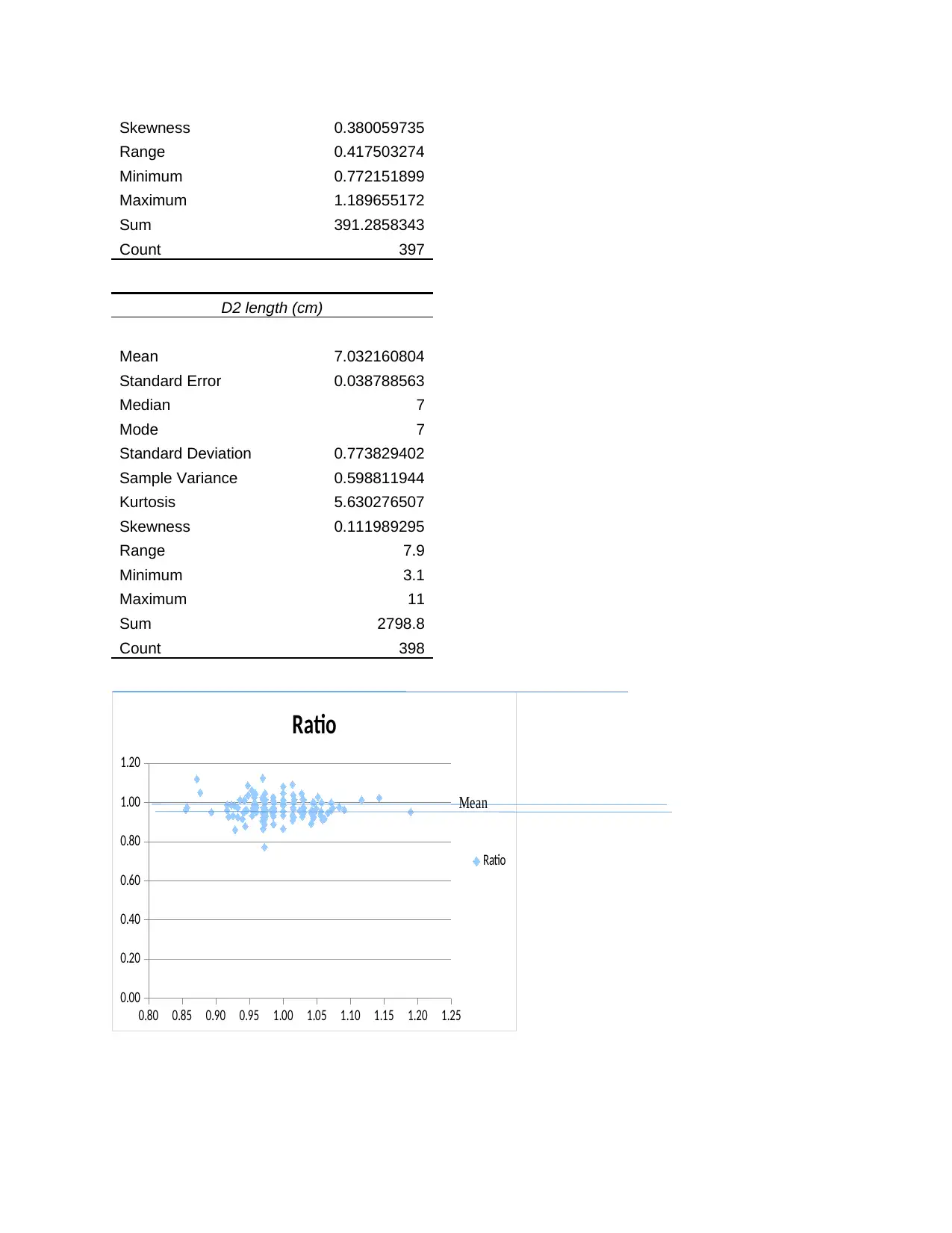
Skewness 0.380059735
Range 0.417503274
Minimum 0.772151899
Maximum 1.189655172
Sum 391.2858343
Count 397
D2 length (cm)
Mean 7.032160804
Standard Error 0.038788563
Median 7
Mode 7
Standard Deviation 0.773829402
Sample Variance 0.598811944
Kurtosis 5.630276507
Skewness 0.111989295
Range 7.9
Minimum 3.1
Maximum 11
Sum 2798.8
Count 398
0.80 0.85 0.90 0.95 1.00 1.05 1.10 1.15 1.20 1.25
0.00
0.20
0.40
0.60
0.80
1.00
1.20
Ratio
Ratio
Mean
Range 0.417503274
Minimum 0.772151899
Maximum 1.189655172
Sum 391.2858343
Count 397
D2 length (cm)
Mean 7.032160804
Standard Error 0.038788563
Median 7
Mode 7
Standard Deviation 0.773829402
Sample Variance 0.598811944
Kurtosis 5.630276507
Skewness 0.111989295
Range 7.9
Minimum 3.1
Maximum 11
Sum 2798.8
Count 398
0.80 0.85 0.90 0.95 1.00 1.05 1.10 1.15 1.20 1.25
0.00
0.20
0.40
0.60
0.80
1.00
1.20
Ratio
Ratio
Mean
Paraphrase This Document
Need a fresh take? Get an instant paraphrase of this document with our AI Paraphraser
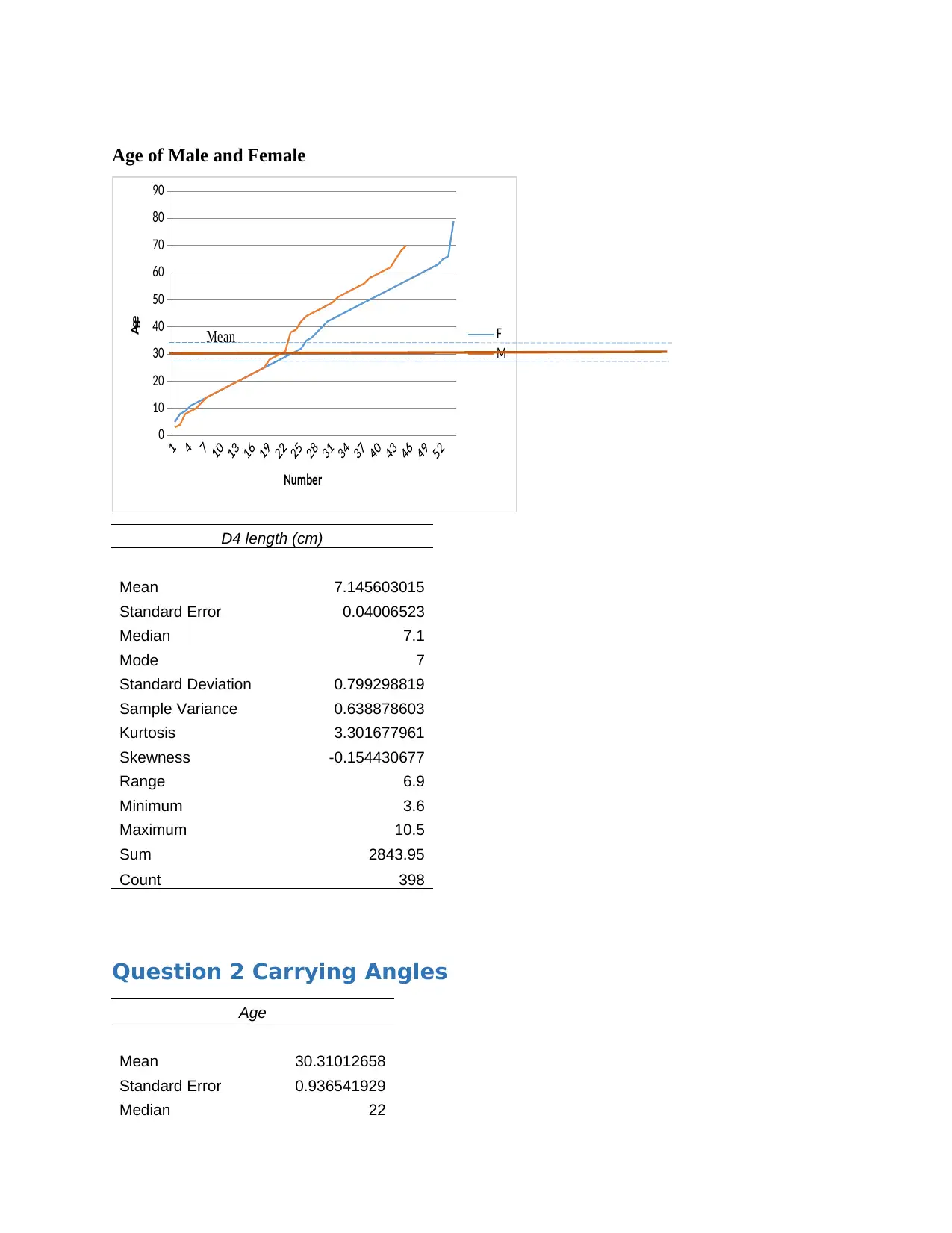
Age of Male and Female
0
10
20
30
40
50
60
70
80
90
F
M
Number
Age
Mean
D4 length (cm)
Mean 7.145603015
Standard Error 0.04006523
Median 7.1
Mode 7
Standard Deviation 0.799298819
Sample Variance 0.638878603
Kurtosis 3.301677961
Skewness -0.154430677
Range 6.9
Minimum 3.6
Maximum 10.5
Sum 2843.95
Count 398
Question 2 Carrying Angles
Age
Mean 30.31012658
Standard Error 0.936541929
Median 22
0
10
20
30
40
50
60
70
80
90
F
M
Number
Age
Mean
D4 length (cm)
Mean 7.145603015
Standard Error 0.04006523
Median 7.1
Mode 7
Standard Deviation 0.799298819
Sample Variance 0.638878603
Kurtosis 3.301677961
Skewness -0.154430677
Range 6.9
Minimum 3.6
Maximum 10.5
Sum 2843.95
Count 398
Question 2 Carrying Angles
Age
Mean 30.31012658
Standard Error 0.936541929
Median 22
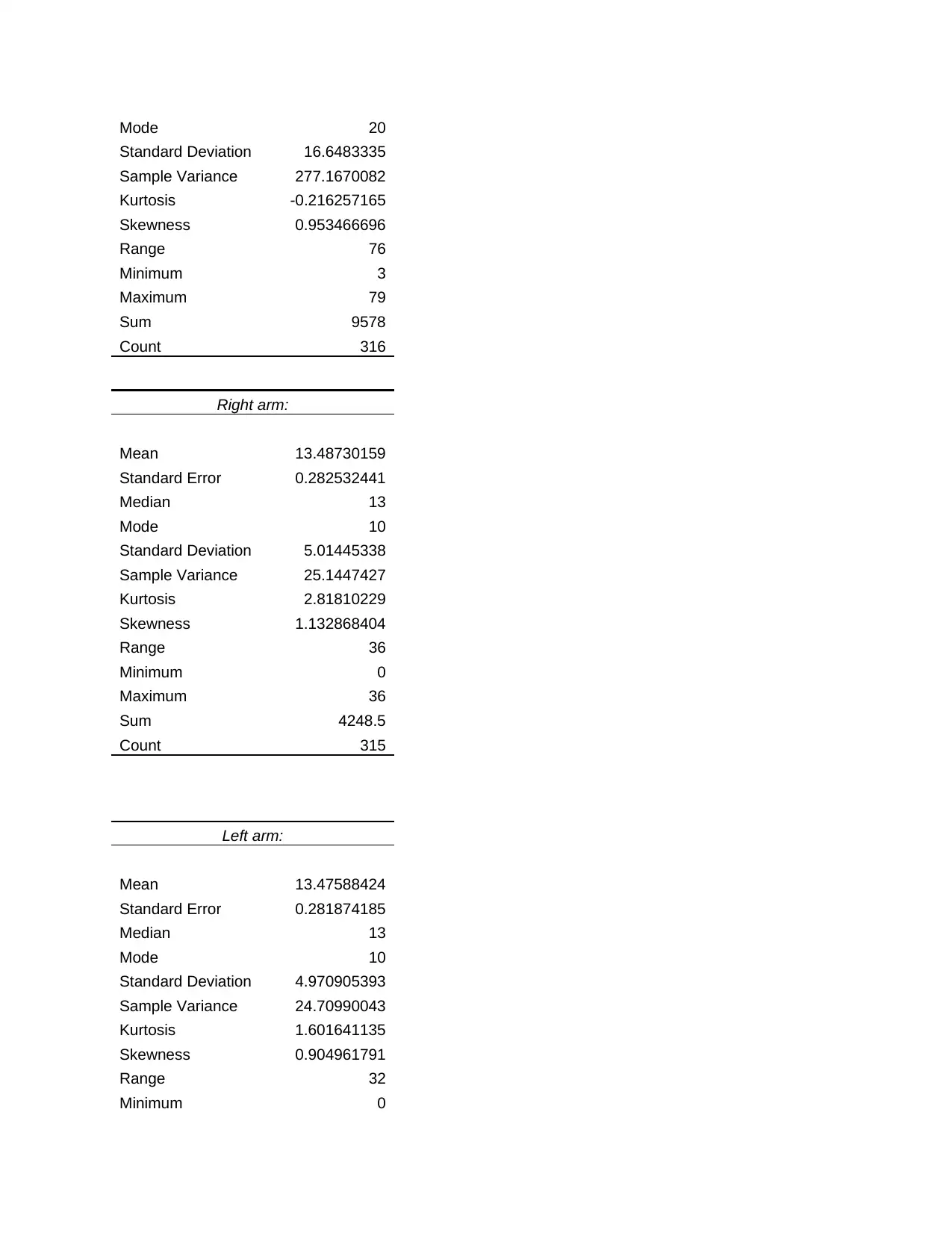
Mode 20
Standard Deviation 16.6483335
Sample Variance 277.1670082
Kurtosis -0.216257165
Skewness 0.953466696
Range 76
Minimum 3
Maximum 79
Sum 9578
Count 316
Right arm:
Mean 13.48730159
Standard Error 0.282532441
Median 13
Mode 10
Standard Deviation 5.01445338
Sample Variance 25.1447427
Kurtosis 2.81810229
Skewness 1.132868404
Range 36
Minimum 0
Maximum 36
Sum 4248.5
Count 315
Left arm:
Mean 13.47588424
Standard Error 0.281874185
Median 13
Mode 10
Standard Deviation 4.970905393
Sample Variance 24.70990043
Kurtosis 1.601641135
Skewness 0.904961791
Range 32
Minimum 0
Standard Deviation 16.6483335
Sample Variance 277.1670082
Kurtosis -0.216257165
Skewness 0.953466696
Range 76
Minimum 3
Maximum 79
Sum 9578
Count 316
Right arm:
Mean 13.48730159
Standard Error 0.282532441
Median 13
Mode 10
Standard Deviation 5.01445338
Sample Variance 25.1447427
Kurtosis 2.81810229
Skewness 1.132868404
Range 36
Minimum 0
Maximum 36
Sum 4248.5
Count 315
Left arm:
Mean 13.47588424
Standard Error 0.281874185
Median 13
Mode 10
Standard Deviation 4.970905393
Sample Variance 24.70990043
Kurtosis 1.601641135
Skewness 0.904961791
Range 32
Minimum 0
⊘ This is a preview!⊘
Do you want full access?
Subscribe today to unlock all pages.

Trusted by 1+ million students worldwide
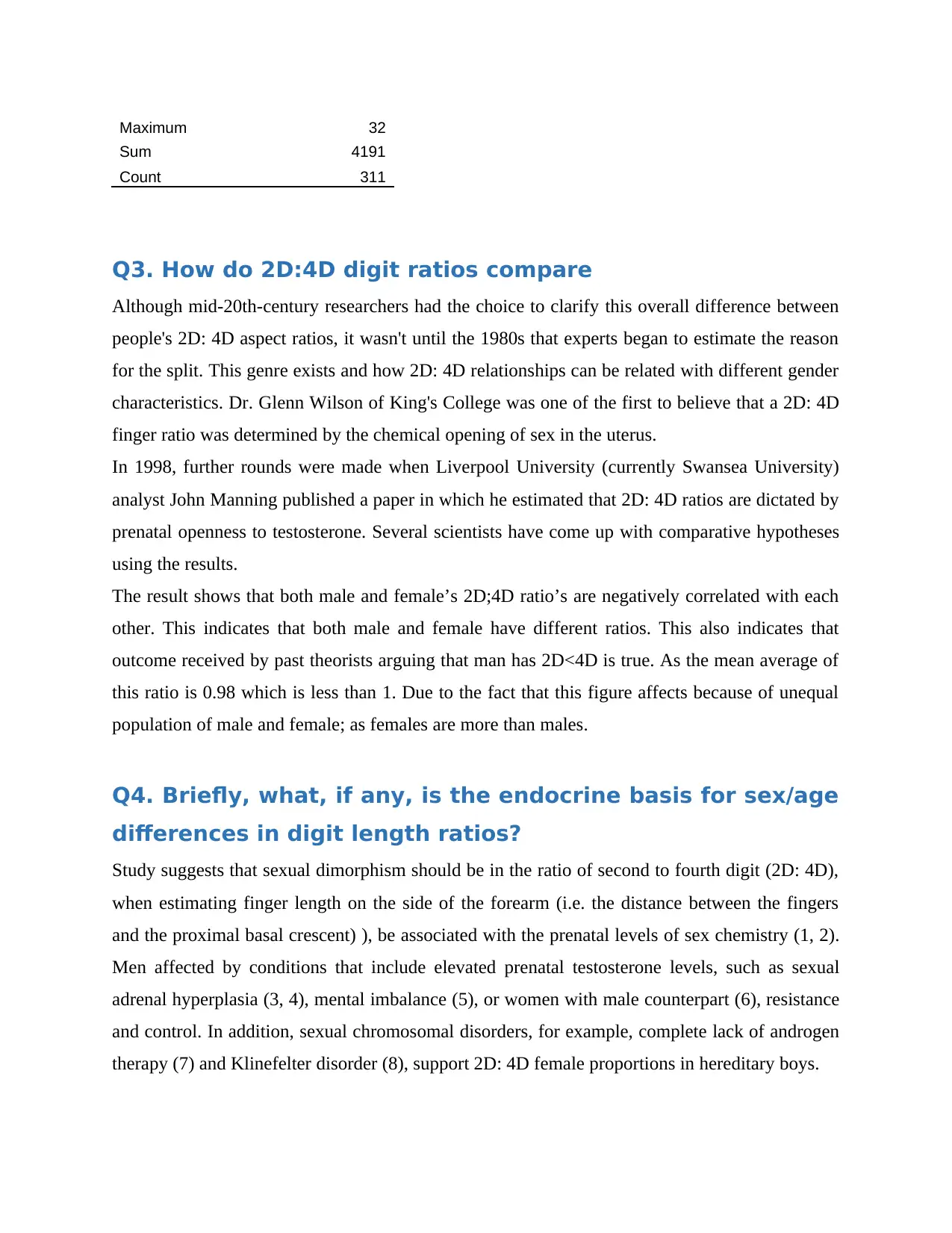
Maximum 32
Sum 4191
Count 311
Q3. How do 2D:4D digit ratios compare
Although mid-20th-century researchers had the choice to clarify this overall difference between
people's 2D: 4D aspect ratios, it wasn't until the 1980s that experts began to estimate the reason
for the split. This genre exists and how 2D: 4D relationships can be related with different gender
characteristics. Dr. Glenn Wilson of King's College was one of the first to believe that a 2D: 4D
finger ratio was determined by the chemical opening of sex in the uterus.
In 1998, further rounds were made when Liverpool University (currently Swansea University)
analyst John Manning published a paper in which he estimated that 2D: 4D ratios are dictated by
prenatal openness to testosterone. Several scientists have come up with comparative hypotheses
using the results.
The result shows that both male and female’s 2D;4D ratio’s are negatively correlated with each
other. This indicates that both male and female have different ratios. This also indicates that
outcome received by past theorists arguing that man has 2D<4D is true. As the mean average of
this ratio is 0.98 which is less than 1. Due to the fact that this figure affects because of unequal
population of male and female; as females are more than males.
Q4. Briefly, what, if any, is the endocrine basis for sex/age
differences in digit length ratios?
Study suggests that sexual dimorphism should be in the ratio of second to fourth digit (2D: 4D),
when estimating finger length on the side of the forearm (i.e. the distance between the fingers
and the proximal basal crescent) ), be associated with the prenatal levels of sex chemistry (1, 2).
Men affected by conditions that include elevated prenatal testosterone levels, such as sexual
adrenal hyperplasia (3, 4), mental imbalance (5), or women with male counterpart (6), resistance
and control. In addition, sexual chromosomal disorders, for example, complete lack of androgen
therapy (7) and Klinefelter disorder (8), support 2D: 4D female proportions in hereditary boys.
Sum 4191
Count 311
Q3. How do 2D:4D digit ratios compare
Although mid-20th-century researchers had the choice to clarify this overall difference between
people's 2D: 4D aspect ratios, it wasn't until the 1980s that experts began to estimate the reason
for the split. This genre exists and how 2D: 4D relationships can be related with different gender
characteristics. Dr. Glenn Wilson of King's College was one of the first to believe that a 2D: 4D
finger ratio was determined by the chemical opening of sex in the uterus.
In 1998, further rounds were made when Liverpool University (currently Swansea University)
analyst John Manning published a paper in which he estimated that 2D: 4D ratios are dictated by
prenatal openness to testosterone. Several scientists have come up with comparative hypotheses
using the results.
The result shows that both male and female’s 2D;4D ratio’s are negatively correlated with each
other. This indicates that both male and female have different ratios. This also indicates that
outcome received by past theorists arguing that man has 2D<4D is true. As the mean average of
this ratio is 0.98 which is less than 1. Due to the fact that this figure affects because of unequal
population of male and female; as females are more than males.
Q4. Briefly, what, if any, is the endocrine basis for sex/age
differences in digit length ratios?
Study suggests that sexual dimorphism should be in the ratio of second to fourth digit (2D: 4D),
when estimating finger length on the side of the forearm (i.e. the distance between the fingers
and the proximal basal crescent) ), be associated with the prenatal levels of sex chemistry (1, 2).
Men affected by conditions that include elevated prenatal testosterone levels, such as sexual
adrenal hyperplasia (3, 4), mental imbalance (5), or women with male counterpart (6), resistance
and control. In addition, sexual chromosomal disorders, for example, complete lack of androgen
therapy (7) and Klinefelter disorder (8), support 2D: 4D female proportions in hereditary boys.
Paraphrase This Document
Need a fresh take? Get an instant paraphrase of this document with our AI Paraphraser
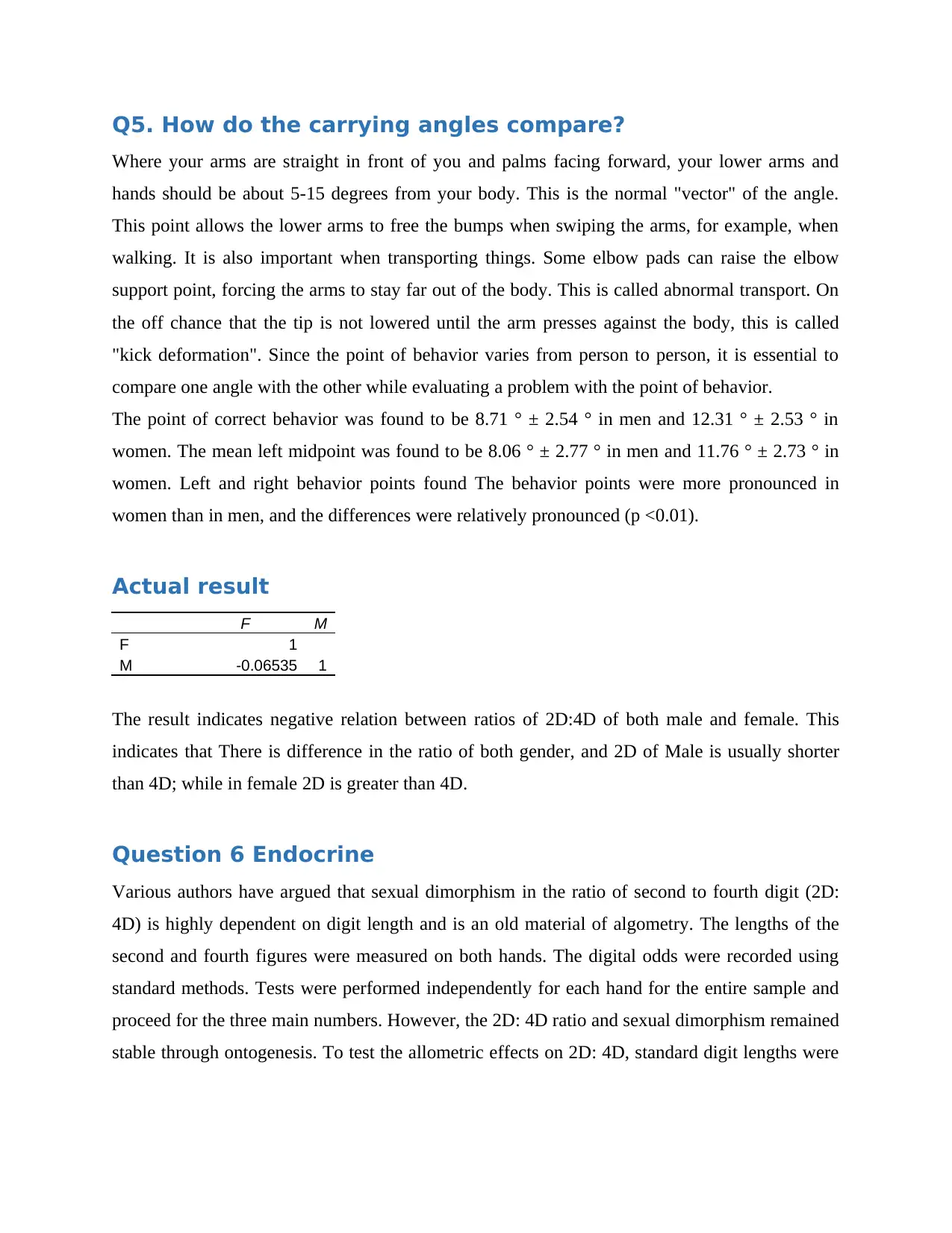
Q5. How do the carrying angles compare?
Where your arms are straight in front of you and palms facing forward, your lower arms and
hands should be about 5-15 degrees from your body. This is the normal "vector" of the angle.
This point allows the lower arms to free the bumps when swiping the arms, for example, when
walking. It is also important when transporting things. Some elbow pads can raise the elbow
support point, forcing the arms to stay far out of the body. This is called abnormal transport. On
the off chance that the tip is not lowered until the arm presses against the body, this is called
"kick deformation". Since the point of behavior varies from person to person, it is essential to
compare one angle with the other while evaluating a problem with the point of behavior.
The point of correct behavior was found to be 8.71 ° ± 2.54 ° in men and 12.31 ° ± 2.53 ° in
women. The mean left midpoint was found to be 8.06 ° ± 2.77 ° in men and 11.76 ° ± 2.73 ° in
women. Left and right behavior points found The behavior points were more pronounced in
women than in men, and the differences were relatively pronounced (p <0.01).
Actual result
F M
F 1
M -0.06535 1
The result indicates negative relation between ratios of 2D:4D of both male and female. This
indicates that There is difference in the ratio of both gender, and 2D of Male is usually shorter
than 4D; while in female 2D is greater than 4D.
Question 6 Endocrine
Various authors have argued that sexual dimorphism in the ratio of second to fourth digit (2D:
4D) is highly dependent on digit length and is an old material of algometry. The lengths of the
second and fourth figures were measured on both hands. The digital odds were recorded using
standard methods. Tests were performed independently for each hand for the entire sample and
proceed for the three main numbers. However, the 2D: 4D ratio and sexual dimorphism remained
stable through ontogenesis. To test the allometric effects on 2D: 4D, standard digit lengths were
Where your arms are straight in front of you and palms facing forward, your lower arms and
hands should be about 5-15 degrees from your body. This is the normal "vector" of the angle.
This point allows the lower arms to free the bumps when swiping the arms, for example, when
walking. It is also important when transporting things. Some elbow pads can raise the elbow
support point, forcing the arms to stay far out of the body. This is called abnormal transport. On
the off chance that the tip is not lowered until the arm presses against the body, this is called
"kick deformation". Since the point of behavior varies from person to person, it is essential to
compare one angle with the other while evaluating a problem with the point of behavior.
The point of correct behavior was found to be 8.71 ° ± 2.54 ° in men and 12.31 ° ± 2.53 ° in
women. The mean left midpoint was found to be 8.06 ° ± 2.77 ° in men and 11.76 ° ± 2.73 ° in
women. Left and right behavior points found The behavior points were more pronounced in
women than in men, and the differences were relatively pronounced (p <0.01).
Actual result
F M
F 1
M -0.06535 1
The result indicates negative relation between ratios of 2D:4D of both male and female. This
indicates that There is difference in the ratio of both gender, and 2D of Male is usually shorter
than 4D; while in female 2D is greater than 4D.
Question 6 Endocrine
Various authors have argued that sexual dimorphism in the ratio of second to fourth digit (2D:
4D) is highly dependent on digit length and is an old material of algometry. The lengths of the
second and fourth figures were measured on both hands. The digital odds were recorded using
standard methods. Tests were performed independently for each hand for the entire sample and
proceed for the three main numbers. However, the 2D: 4D ratio and sexual dimorphism remained
stable through ontogenesis. To test the allometric effects on 2D: 4D, standard digit lengths were

determined. Both gender and population were stable consistent markers of 2D: 4D, although the
normal length was not normal.
normal length was not normal.
⊘ This is a preview!⊘
Do you want full access?
Subscribe today to unlock all pages.

Trusted by 1+ million students worldwide
1 out of 9
Related Documents
Your All-in-One AI-Powered Toolkit for Academic Success.
+13062052269
info@desklib.com
Available 24*7 on WhatsApp / Email
![[object Object]](/_next/static/media/star-bottom.7253800d.svg)
Unlock your academic potential
Copyright © 2020–2025 A2Z Services. All Rights Reserved. Developed and managed by ZUCOL.





